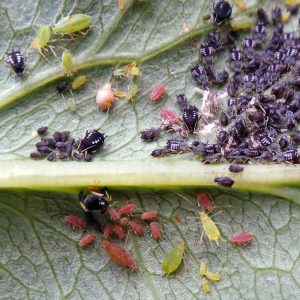
Aphids are primarily northern temperate zone insects all in the family Aphididae of the order Hemiptera, with about 1,350 species in North America (5,000 worldwide), although only a handful are considered serious pests. Most aphids are about 1/8 inch long and all are soft-bodied. Their pear-shaped bodies have “exhaust pipes” (cornicles) protruding from the back end of the abdomen (used to exude droplets of a quick-hardening defensive fluid called cornicle wax).
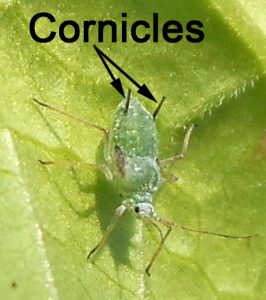
Many species are green but others are white, yellow, red (pink), brown, black, or mottled. Many species have two color types, such as the green peach aphid, which has both a green and a red form.
Some, such as the cabbage aphid or wooly apple aphid, secrete a white or gray waxy substance that covers the body. Adult aphids may be winged or wingless.
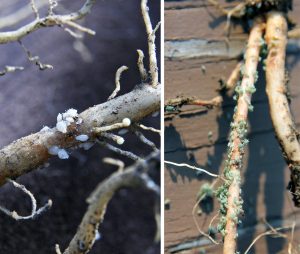
They have sucking mouthparts and feed exclusively on plant sap. Aphids feed on stems, leaves, and even roots! They reproduce rapidly to form colonies or clumps, particularly on new growth.
The life cycle of most species is rather complex. In Wisconsin aphids spend the winter as eggs. When these hatch in the spring, they produce only wingless females that give birth to live young (viviparity; without mating = parthenogenetic reproduction). Each female aphid reproduces for a period of 20–30 days, giving birth to 60–100 live nymphs. The nymphs look like the adults but are smaller. The nymphs mature and can produce offspring within a week when temperatures are high.
Eggs within these females start to develop long before birth so that a newly born aphid can contain within herself not only the developing embryos of her daughters but also those of her granddaughters which are developing within her daughters. This “telescoping of generations” means aphids can build up immense populations very quickly. Under ideal conditions, one aphid could theoretically produce billions of offspring by the end of a growing season. Obviously this doesn’t happen, since natural controls – such as weather and predators – eliminate significant numbers of aphids.
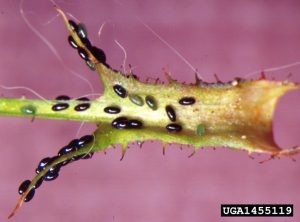
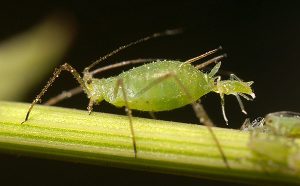
After several generations, when the food supply becomes short or the area becomes overcrowded, winged females (alates) appear. These winged females fly to new host plants and produce many more generations of wingless females. At the end of the summer, when temperatures begin to drop and daylength decreases, both males and females are produced. These aphids mate and the females lay eggs on the appropriate host plant.
Although aphids are generally weak fliers, some species migrate considerable distances. They accomplish this by flying upward to be carried by fast-moving, low level jet streams. Several species, such as the English grain aphid, corn leaf aphid, bird-cherry oat aphid and greenbug (as well as some pest leafhoppers and moths) catch a ride on the prevailing winds in the spring to move from southern areas to the Midwest each year. In addition to this natural movement, aphids have also been spread by humans, making some species nearly cosmopolitan in their distribution.

Only 25% of all plant species are infested with aphids; the aster or sunflower family (Asteraceae), conifers and the rose family (Rosaceae) support the highest number of aphid species. Most species of aphids are monophagous or feed on just a few species of closely related plants. About 10% of aphid species, however, have a primary woody host where they spend autumn, winter and spring and an unrelated, secondary herbaceous host plant for the summer. For example, the rosy apple aphid has apple as its primary host and plantain (Plantago lanceolata) as its secondary host. Only a few species have a wide range of secondary hosts but these tend to be important pests, such as the green peach aphid.
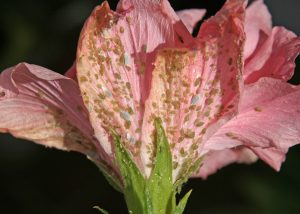
Aphids feed by inserting their mouthparts into phloem vessels through leaves, buds, stems, or roots and sucking out the sap. Some species probe through stomata but most just jab through the plant’s cells. Their mouthparts are very thin, so to prevent damage during insertion, they secrete a special liquid that hardens quickly to form a protective sheath as they slowly push their mouthparts into the plant. (It can take anywhere from 25 minutes to 24 hours from starting to insert the mouthparts to actually getting something to eat.) Once the phloem is reached, the aphid injects saliva that probably helps prevent the plant cell from sealing the puncture.
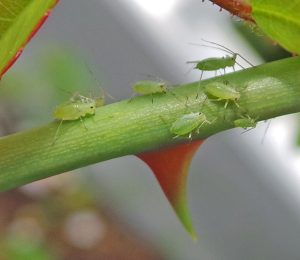
Plant phloem has lots of sugars but not many amino-acids or nitrogen. In order to get enough nitrogen in their diet, aphids must ingest far more sugar and liquid than they need. They have special filters in their digestive system to help excrete the excess sugar water, called honeydew. This sticky honeydew coats the plant’s leaves, other plants, picnic tables, cars or anything else below where the aphids are feeding. Sooty molds may develop on the honeydew, covering the plant’s leaves with unattractive black growth and reducing the photosynthetic ability of the plant.
Some species of ants are attracted to and feed on the honeydew. Ants will protect the aphids from natural enemies and will actually carry them to new plants when the food source is depleted. Some ants even go so far as to build small shelters for the aphids or to keeping root-feeding aphids inside their own nests. A few species of aphids have become so dependent on their ants that they won’t even excrete honeydew unless stimulated by an ant! However, if aphid numbers get too high the ants will feed a few aphids to their larvae. And the ants are better at protecting their aphid herds from some natural enemies (such as ladybugs) than others (such as lacewings or hover fly larvae). Not only do they fight off or kill the predators but they also remove the eggs of some.
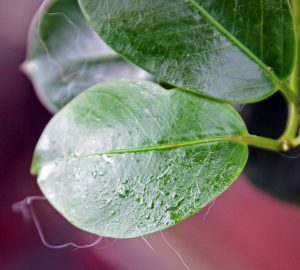
Of course, aphids are also pests because of their feeding causing a variety of symptoms. Although aphids are generally present at non-injurious levels on most plants, large numbers of aphids can reduce the growth rate or vigor of plants from excessive sap removal. Chlorotic spots may develop where cell contents have been removed or there may be general yellowing. Bud feeding results in distorted leaves and, at high densities, can cause stunting and/or wilting. Severe damage to the top of the plant may reduce the number of flowers produced. Some species inject chemicals into the plant that change the growth pattern, causing new plant growth to be distorted or stunted. And some species of aphids transmit plant viruses including cauliflower mosaic, cucumber mosaic, lettuce mosaic, plum pox, potato virus Y, tobacco mosaic, and turnip mosaic viruses. In general, aphid feeding will not seriously harm healthy, established trees and shrubs but high populations on herbaceous plants can be a significant problem.
Some of the most common or conspicuous pest species in the Midwest include:
- Green peach aphid (Myzus persicae) is the most common aphid in the home garden, with over 500 host plants. The adults are yellowish-green or reddish, with three dark lines on their back. It is often found on vegetables (especially potato), fruit trees (cherry and plum), and ornamentals including carnation, chrysanthemum, English ivy, iris, lily, poppies, rose, snapdragon, tulip, and violet.
- Cabbage aphid (Brevicoryne brassicae) is a small gray-green aphid with a powdery, waxy covering, found in dense clusters on the underside of leaves. Broccoli is frequently infested. Other hosts include cabbage, cauliflower, brussels sprouts, kohlrabi, collards, kale, and radish.
- Melon or cotton aphid (Aphis gossypii) is a very small dark green aphid with black cornicles. It can be found on all the common home vegetables, especially melons.
- Oleander aphid (Aphis nerii) is a bright yellow introduced aphid that infests milkweeds and a few other plants.
- Potato aphid (Macrosiphum euphorbiae) is a vector of virus and mosaic diseases of potato and tomato. It attacks many garden and ornamental plants as well as weeds. Interestingly, this aphid uses the rose canes in the fall and hatch in the spring into pink and green aphids that feed on rose buds and young leaves. In early summer the aphids migrate to other host plants.
- Rose aphid (Macrosiphum rosae) is a host-limited species common to all rose gardens. Adults are light green to pink with black appendages.
- Woolly apple aphid (Eriosoma lanigerum) feeds on the bark and roots of apple, causing a swollen gall to form on the stems where aphids have fed. They also produce waxy filaments on the abdomen, creating a woolly appearance.
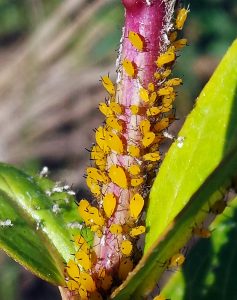
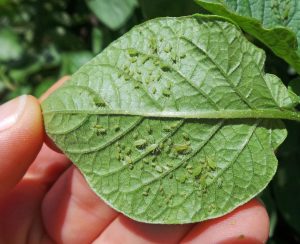
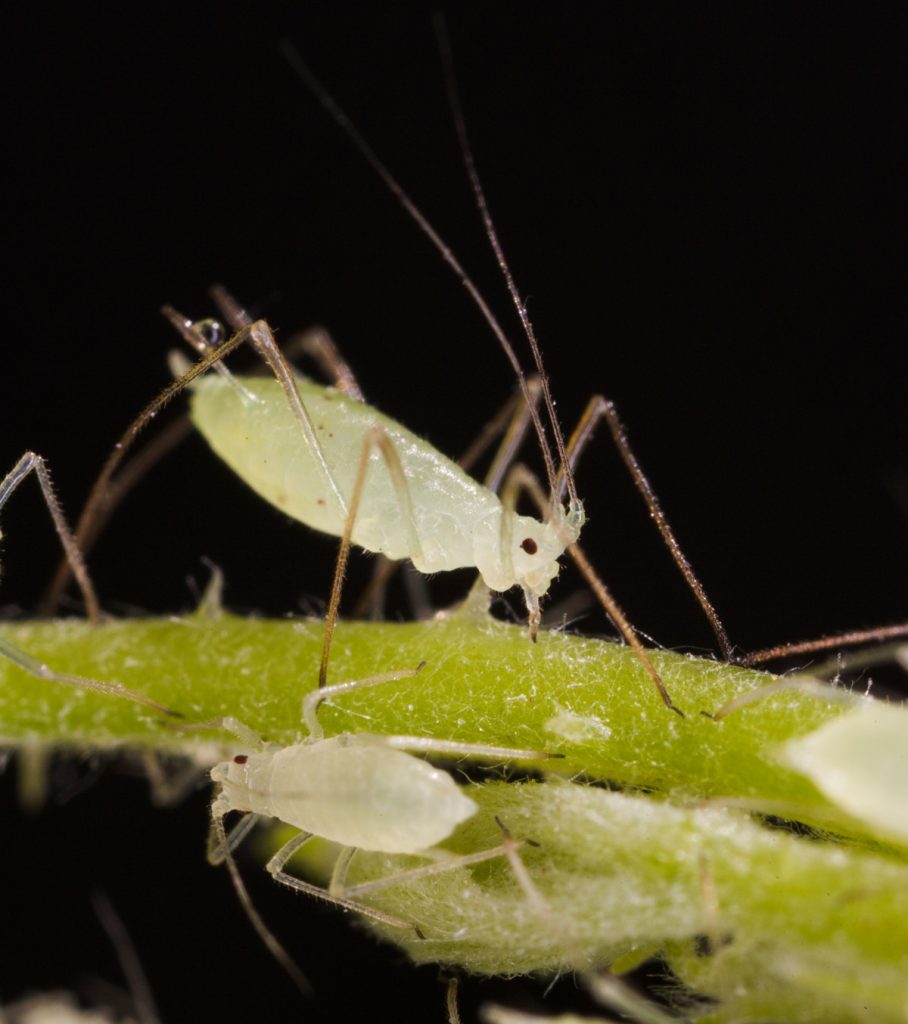
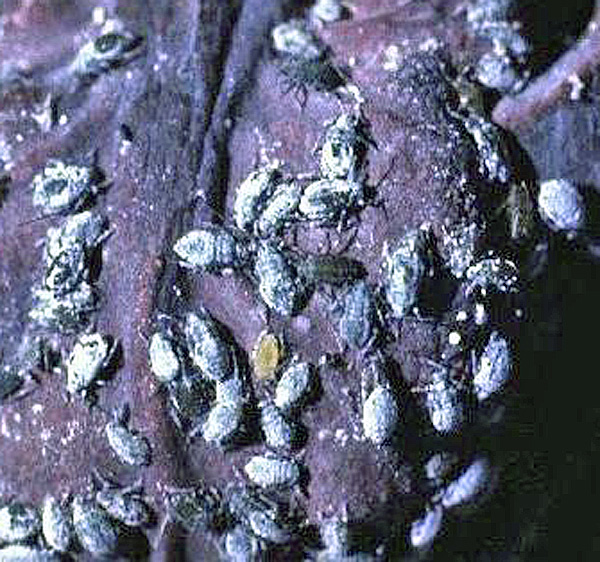
Aphids are relatively common and often occur in large numbers, so there are many animals which use aphids as a food source. Most people think of lady beetles as the aphid predator but there’s actually a long list of natural enemies of aphids. Numerous parasites, predators, and pathogens attack aphids. Some of the most common ones that specialize on aphids include:
- Aphid midge (Aphidoletes aphidomyza; Cecidomyiidae) – small, fungus-gnat-like adults give rise to bright orange, slug-like larvae that inject a toxin into aphids’ leg joints to paralyze them, then suck out the aphid body contents through a hole chewed in the thorax.
- Brown lacewings (Hemerobiidae) – are similar to green lacewings but tend to be smaller. The adults are brown and the eggs are not stalked. They are frequently found in trees.
- Green lacewings (Chrysopidae) – are voracious aphid predators as larvae; only a few species feed as adults. Chrysoperla carnea and other species are available to purchase for release, as well as occurring naturally.
- Hover flies (Syrphidae) – also called flower flies or syrphids, the adult resemble honey bees or wasps but it’s the slug-like, pale green to yellow maggots that eat aphids.
- Lady beetles (Coccinellidae) – numerous species occur throughout the Midwest, feeding as both adults and larvae on aphids. Some common species include Asian multicolored, two spotted, seven spotted and twelve spotted ladybeetles.
- Minute pirate bugs (Anthocoridae) – the tiny, distinctively patterned black and white adults and the pinkish-yellow to light brown nymphs and adults are very active and will feed on small aphids.
- Parasitic wasps (Braconidae, Aphelinidae) – most of these wasps have similar developmental processes. Eggs are laid in the aphid and, as larvae, consume it from the inside and in the process the aphid changes into a hardened shell called a mummy. The wasp pupates inside the mummy and later emerges.
- Pathogens – several fungi, including Beauveria bassiana, Paecilomyces fumosoroseus, and Verticillium lecanii, will infect and kill aphids.
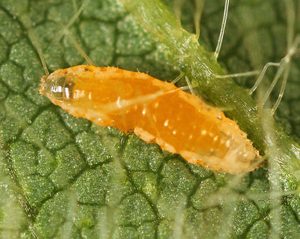
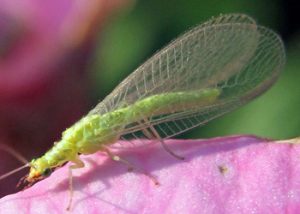
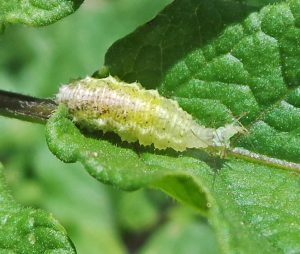
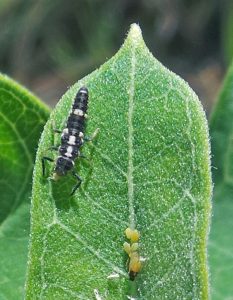
There are many other arthropods that will eat aphids if given the chance including bigeyed bugs, damsel bugs (Nabidae), earwigs, ground beetles (Carabidae), rove beetles (Staphylinidae), spiders and harvestmen, as well as small passerine birds such as goldfinches and sparrows, and other animals.
Aphids are easily monitored in the garden or landscape by visually inspecting the plants. Cast skins, honeydew droplets, and sooty mold are indications of an infestation. Aphid infestations are often localized and different aphid species prefer different parts of the plant, so you should check the entire plant rather than just the terminals.
But should you do anything about the aphids? That depends their absolute numbers, whether any natural enemies are present, if honeydew is causing problems, the size of the plant and if the plant’s growth is being affected, and your tolerance for their presence. Natural controls often bring aphid populations under control shortly after they become noticeable. If there are numerous lady bird beetles or lacewing larvae on the plant, or many aphids are parasitized (are mummies), those natural controls should be given a chance to do the job first. Avoid using broad spectrum insecticides that could kill these natural enemies.
If natural control is not working and aphids are overrunning the plants, there are several management options:
- A strong jet of water will wash many of the aphids off the plant.
- Small numbers of aphids on small plants can be crushed by hand as they are found.
- Insecticidal soap works well, but only kills by contact, so good coverage and frequent applications are necessary (and may be phytotoxic on some plants).
- Horticultural oils can be used on some plants.
- Release purchased natural enemies, especially green lacewings or lady beetles. This is most effective in enclosed spaces.
- Many insecticide products, both organic and synthetic, are available. Be sure to select a product labeled for control of aphids on the plant(s) that are infested. Read and carefully follow the directions on the label.
- Varieties are now available that are resistant to honeysuckle witches broom aphid (‘Freedom’ Honeysuckle).

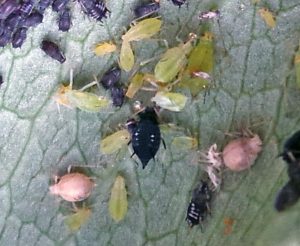
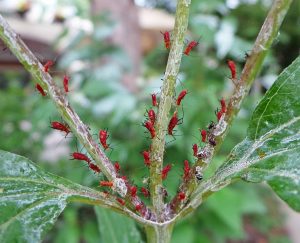
– Susan Mahr, University of Wisconsin – Madison





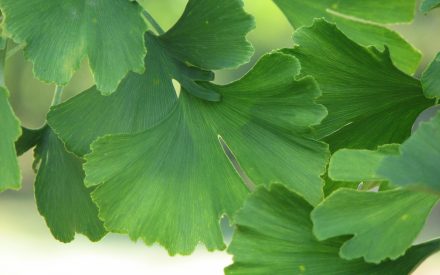 Trees and Shrubs for Diversity and Climate Change
Trees and Shrubs for Diversity and Climate Change Apple Pest Management for Home Gardeners
Apple Pest Management for Home Gardeners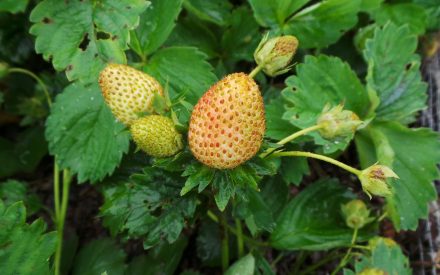 Angular Leaf Spot of Strawberry
Angular Leaf Spot of Strawberry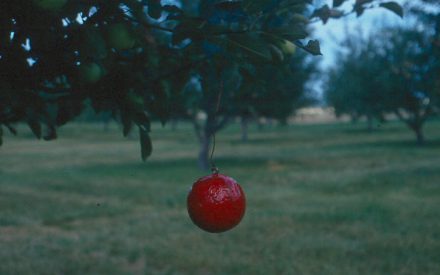 Apple Maggot
Apple Maggot


